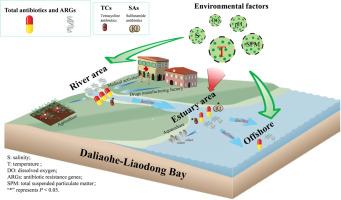大辽河-辽东湾水域抗生素和ARGs的区域分布特征及其环境影响因素
IF 6.3
2区 环境科学与生态学
Q1 ENVIRONMENTAL SCIENCES
引用次数: 0
摘要
本文以大辽河-辽东湾水体为研究对象,将其划分为内河、河口、近海三个区域,从这一角度分析内河向海抗生素及抗生素耐药基因(ARGs)的变化及其环境影响因素。结果表明,大辽河-辽东湾地区抗生素和ARGs污染总体上属于中低水平,抗生素和ARGs含量分别为- 106.23 ng/L和- 1.95 × 108 copies/L。抗生素和ARGs的浓度和种类从内陆向海洋呈下降趋势。从区域化的角度分析抗生素和ARGs的分布特征,发现三个地区在磺胺类抗生素、四环素类抗生素和优势ARGs方面存在显著差异。河口地区磺胺类抗生素含量显著高于河滨和近海地区;河流和河口地区的四环素抗生素水平明显高于近海地区。河、河口带以氨基糖苷类为主,近海带以大环内酯类为主。我们分析了环境因素对抗生素和ARGs分配的影响,发现总温度对抗生素和ARGs的变化贡献最大;溶解氧的贡献最低。受这些因素影响最大的是河口带,其次是近海带,最后是内河带。本文章由计算机程序翻译,如有差异,请以英文原文为准。

Characteristics of regionalized distribution of antibiotics and ARGs in Daliao River-Liaodong Bay waters and their environmental impact factors
This paper takes the water body of Daliao River-Liaodong Bay as the research object, divides it into three regions: river, estuary, and offshore, and analyzes the changes of antibiotics and antibiotic resistance genes (ARGs) from inland rivers to the sea and the environmental impact factors from this perspective. The results showed that in general, the pollution of antibiotics and ARGs in Daliao River-Liaodong Bay belonged to the medium-low level, and levels of antibiotics and ARGs were nd–106.23 ng/L and nd–1.95 × 108 copies/L, respectively. The concentrations and types of antibiotics and ARGs decreased from inland to sea regions. Analysis of the distributional characteristics of antibiotics and ARGs from a regionalized perspective revealed significant differences among the three regions in sulfonamide antibiotics, tetracycline antibiotics, and dominant ARGs. Sulfonamide antibiotic levels were significantly higher in the estuarine zone than in the riverine and offshore zones; tetracycline antibiotic levels were significantly higher in the riverine and estuarine zones than in the offshore zone. Aminoglycosides were dominant in the riverine and estuarine zones, and macrolides were dominant in the offshore zone. We characterized the effects of environmental factors on the assignment of antibiotics and ARGs and found that overall temperature contributed the most to variation in antibiotics and ARGs; the contribution of dissolved oxygen was the lowest. The estuarine zone was most affected by these factors, followed by the offshore zone and finally the riverine zone.
求助全文
通过发布文献求助,成功后即可免费获取论文全文。
去求助
来源期刊

Journal of Environmental Sciences-china
环境科学-环境科学
CiteScore
13.70
自引率
0.00%
发文量
6354
审稿时长
2.6 months
期刊介绍:
The Journal of Environmental Sciences is an international journal started in 1989. The journal is devoted to publish original, peer-reviewed research papers on main aspects of environmental sciences, such as environmental chemistry, environmental biology, ecology, geosciences and environmental physics. Appropriate subjects include basic and applied research on atmospheric, terrestrial and aquatic environments, pollution control and abatement technology, conservation of natural resources, environmental health and toxicology. Announcements of international environmental science meetings and other recent information are also included.
 求助内容:
求助内容: 应助结果提醒方式:
应助结果提醒方式:


